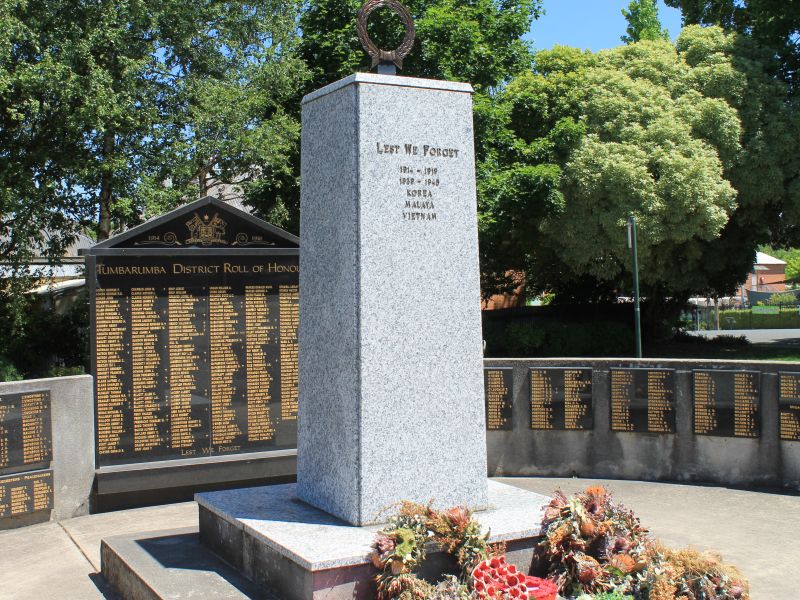Charles Stratton
Charles was born in Corryong in 1875, the sixth of ten children to Robert and Marian Annie (née Grant) Stratton. The Stratton family would live in a number of different locations, including Osborne’s Flat, Corryong, Tintaldra and Uranquinty, before settling in the Taradale and Tumbarumba area. Five years after Charles’ birth, his father gained employment as a teacher at Uranquinty, NSW, just south-west of Wagga Wagga.
It was on Wednesday the 15th of August 1915 that the residents of Tumbarumba gave Charles and a number of other local lads an enthusiastic farewell as they left to travel to Cootamundra by car. The other members of the party included Bernard and Roy Horsely, William Livingstone, Richard Stewart and John Dawson.
Five days later, Charles signed his attestation papers at Cootamundra Military Training Camp, enlisting in the 10th Reinforcements of the 19th Battalion and being allocated the Regimental Number 4281.
Private Charles Stratton embarked on HMAT A67 Orsova on the 11th of March 1916, disembarking at Alexandria in Egypt. On the 10th of May, the 10th Reinforcements embarked on the HMT Scotian and sailed to the Port of Marseilles, where they disembarked one week later. Charles then underwent the extra training required for him to learn the skills and techniques of the type of warfare he would encounter at the front. He was finally taken on strength with the 19th Battalion on the1st of August.
The new year saw Charles being detached to the loading party of the Divisional Train, assisting with the loading, movement and unloading of supplies and equipment. In August of 1917 it is recorded that he spent two weeks on leave in England. September through to early December was spent between a number of different hospitals, including the 39th General Hospital, where he was recovering from a case of gonorrhea. He finally rejoined his unit in Belgium on the 4th of January 1918.
Whilst Charles was overseas his father and one of his sisters, Florence, were involved in a tragic episode. The 27th of December 1917 edition of the Wagga Wagga Daily Advertiser reported the incident.
“WOMAN’S CLOTHES IGNITE.
AGED FATHER FATALLY BURNED
WHILE ASSISTING DAUGHTERWhile Miss Florence Stratton, 30, daughter of Mr. Robert Stratton, of Taradale, 17 miles from Tumbarumba, was making tea at an open fireplace at her father’s home at Taradale at dinner time on Friday last, the dress she was wearing caught fire and flames almost immediately enveloped her.
Miss Stratton screamed and her father, who was seated at the table in the same room having his mid-day meal, ran to her assistance and tried to extinguish the burning material. The screams of the unfortunate woman also attracted the attention of Mrs. J.F. Stratton, who lives near-by. Hurrying to the scene she found her sister-in-law enveloped in flames with her aged father trying to save her. Mrs Stratton went to Miss Stratton’s aid but the latter, maddened by pain, struggled, and getting free, rushed out of the building. Mrs Stratton followed quickly and overtaking her under the verandah, threw a rug around her and smothered the flames.”
Robert was taken to the Wagga Wagga hospital but died of his injuries on the Tuesday. Florence passed away on the 7th of February the following year. It is not known how Charles took the news of the deaths.
Exactly three months after rejoining his battalion in the field, Charles was once again admitted to the 41st Casualty Clearing Station. The very next day he died of an illness that was “not yet defined - abdominal”. That day he was buried in the Namps-Au-Val British Cemetery (Plot I, Row G, Grave No. 16), France by Rev. C.B.D Gale.
The 3rd of May 1918 edition of the Albury Banner and Wodonga Express reported the news of Charles’ death.
“The widowed mother of Private Stratton on Tuesday last received a telegram intimating that private Stratton, 10th Battalion had died of wounds on the 5th of April. The deceased Empire defender, who was 42 years of age and unmarried, enlisted in August 1915, and was over two years in the trenches in France. He was a man of estimable qualities and highly respected by all. An in memoriam service to the late Private Stratton will be conducted at St. Jude’s Church on Sunday next at 7:30 p.m.”
On the 21st of June 1918, Charles’ personal effects were packaged up and loaded onto S.S. Barunga. Although not much, these personal items often provided a link with the loved ones that they had lost. Unfortunately, while 150 miles south-west of the Scilly Isles, the Barunga was struck by a torpedo from a German U-boat and sunk. While the 800 sick and wounded on board were all saved, all mail and other cargo, including Charles’ effects, were lost.
Charles is remembered on the Australian War Memorial Roll of Honour, the Corryong War Memorial and the Tumbarumba District Roll of Honour WW1. For his service, he was awarded the British War Medal and the Victory Medal.
 Stephen Learmonth
Stephen Learmonth
